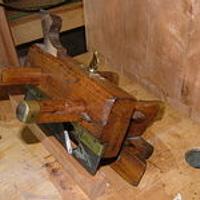Share your craft projects
Make new craft buddies
Ask craft questions
Blog your craft journey

Dave Polaschek
2140 posts
and
43 followers
in about 3 years
in about 3 years
More from Dave Polaschek
Juniper and purple resin bowl #4: Cleanup and finishing prep
Juniper and purple resin bowl #3: Final turning the inside, more patching
Juniper and purple resin bowl #2: Finish turning the exterior, filling fine cracks
Building a cane #14: Joining the pieces
Building a cane #13: Finished the carving, finishing
Juniper and purple resin bowl #1: Start, rough turning, epoxy, and hollowing
This is
part 1
in a
4 part
series:
Juniper and purple resin bowl
-
Start, rough turning, epoxy, and hollowing
-
Finish turning the exterior, filling fine cracks
...
- Start, rough turning, epoxy, and hollowing
- Finish turning the exterior, filling fine cracks
...
Haven’t had time for writing, so this is a big catch-up.
I had a piece of juniper which had a crotch with a large bark inclusion. I looked at it a few different ways before cutting the blank to fit on a faceplate, which I decided would be “down” on the bowl. I quick turned the opposite face flat enough to put another faceplate on that end, flipped the blank, and turned a tenon. I mounted the bowl in a chuck and roughed it to bowl shape, and liked what I saw.
Three epoxy pours later (first one with 5-minute epoxy to fill the bulk of the void with sawdust, since I’ll be turning it away, later two with purple-tinted slow-cure resin), and I had this.
I had a piece of juniper which had a crotch with a large bark inclusion. I looked at it a few different ways before cutting the blank to fit on a faceplate, which I decided would be “down” on the bowl. I quick turned the opposite face flat enough to put another faceplate on that end, flipped the blank, and turned a tenon. I mounted the bowl in a chuck and roughed it to bowl shape, and liked what I saw.
Three epoxy pours later (first one with 5-minute epoxy to fill the bulk of the void with sawdust, since I’ll be turning it away, later two with purple-tinted slow-cure resin), and I had this.

Flipping it over revealed that I still had a little filling to do, so that got another small pour to level things out.

After more rough-turning to remove excess resin and expose the bark inclusion, I really like what I’ve got. The epoxy chipped out a little, so tomorrow I’ll fill in the chips with more purple and give the bowl the weekend to cure, since we have company coming to town.

I also rough-hollowed it, and you can see the hook-shaped bark inclusion from the inside. The wood is still a little damp, and leaving the heartwood in as I did risks some cracking, but I have a plan for that if the bowl cracks over the weekend.

It’s about 6 inches (150mm) across the rim. More tomorrow after I patch up the chipped-out spots, probably, but I think this will be a pretty one when it’s done.
May you have the day you deserve!
9 Comments
fingers crossed dave!
working with my hands is a joy,it gives me a sense of fulfillment,somthing so many seek and so few find.-SAM MALOOF.
Looks like it will be really nice, when done. That puple against the wood looks nice, already .
The Other Steven
Looking good!
So far, so good. I've not turned anything but wood, and I'm thinking you need some very sharp tools to turn epoxy, and that the epoxy is pretty hard on the tool. Correct?
will be very beautiful
*TONY ** Denver * ALWAYS REMEMBER TO HAVE FUN
good luck with it!
Petey
Thanks.
Yeah, Tom. Sharp tools, and they get dull fast if you’re using HSS tools. I have a couple “cryo” bowl gouges that I’ll use, but most of the time I bust out the carbide tools for the epoxy turning. They do a better job of getting most of the bulk turned away without chip-out, as long as I’ve let the epoxy cure completely (I didn’t this time).
The carbide tools will not leave as good of a surface as really sharp HSS tools (there’s always a trade off), so I’ll finish either with freshly sharpened HSS or pop on the dust mask and get out the progressive sheets of sandpaper.
The other thing that can be tricky with turning resin is that it’s similar to turning air on a piece with a crack. The resin is harder than the wood, so when your tool is on the wood, if you let it move too deep, you’ll catch when the edge of the resin comes along. Not a big catch like with a skew where you got the wrong corner down, but still enough to possibly chip some resin rather than cutting it cleanly.
If you’re going to get started, pens are nice practice, because the tools are smaller and cheaper, as are the blanks. You can practice with about a half-dozen different kinds of plastics. Also, practice turning air on pieces that are just wood. It’ll improve your skills when you switch to mixed wood and resin.
Finally, good dust collection and a mask. You don’t want to be inhaling plastic chips and shavings, and at least here in the desert, they will stick to everything. I generally figure after a bowl like this, I’ll need to do one of my more thorough cleanings to get rid of the plastic. As when turning juniper (which gives me an allergic reaction), I come in and head straight to the shower after turning plastic, or I’m in trouble for getting “pretty dust” all over the house. It’s even worse than having an exotic dancer “mark her territory” with glitter, I hear.
Yeah, Tom. Sharp tools, and they get dull fast if you’re using HSS tools. I have a couple “cryo” bowl gouges that I’ll use, but most of the time I bust out the carbide tools for the epoxy turning. They do a better job of getting most of the bulk turned away without chip-out, as long as I’ve let the epoxy cure completely (I didn’t this time).
The carbide tools will not leave as good of a surface as really sharp HSS tools (there’s always a trade off), so I’ll finish either with freshly sharpened HSS or pop on the dust mask and get out the progressive sheets of sandpaper.
The other thing that can be tricky with turning resin is that it’s similar to turning air on a piece with a crack. The resin is harder than the wood, so when your tool is on the wood, if you let it move too deep, you’ll catch when the edge of the resin comes along. Not a big catch like with a skew where you got the wrong corner down, but still enough to possibly chip some resin rather than cutting it cleanly.
If you’re going to get started, pens are nice practice, because the tools are smaller and cheaper, as are the blanks. You can practice with about a half-dozen different kinds of plastics. Also, practice turning air on pieces that are just wood. It’ll improve your skills when you switch to mixed wood and resin.
Finally, good dust collection and a mask. You don’t want to be inhaling plastic chips and shavings, and at least here in the desert, they will stick to everything. I generally figure after a bowl like this, I’ll need to do one of my more thorough cleanings to get rid of the plastic. As when turning juniper (which gives me an allergic reaction), I come in and head straight to the shower after turning plastic, or I’m in trouble for getting “pretty dust” all over the house. It’s even worse than having an exotic dancer “mark her territory” with glitter, I hear.
May you have the day you deserve!
That's gonna pop when you get finish applied!
Fun thing about Juniper is there always will be one more crack to deal with.
When I work with resin, I just use some form of sander with a coarse grit to get through the waste.
I found that even though the resin is hard after a day (fingernail test), it is still "gummy" and will grab any tool that gets near it. 48 Hours later, much better!.
Reading up on the various resins out there, they all seem to have a different time-to-cure spec.
Fun thing about Juniper is there always will be one more crack to deal with.
When I work with resin, I just use some form of sander with a coarse grit to get through the waste.
I found that even though the resin is hard after a day (fingernail test), it is still "gummy" and will grab any tool that gets near it. 48 Hours later, much better!.
Reading up on the various resins out there, they all seem to have a different time-to-cure spec.
Yeah, Splint. I patched up some of the worst chip-outs this afternoon with 5 minute epoxy. Also took a dental pick to some of the edges of the crack, and found another bark inclusion hiding just below the surface, so dug that out and filled it with resin.
We have company arriving tomorrow, so it’ll be Tuesday before I get back in the shop, so mostly I wanted to make sure I had mostly filled that pretty crack. I find that I can turn down the excess a LOT faster with a carbide tool, and it’s a lot less plastic in the air filter and dust mask, so that’s how I usually do it.
Yeah, time to cure vs. time to recoat is different for almost every brand. Of course, I’m pondering switching away from System Three (their prices keep heading the wrong direction, but I’ve got about a half-gallon of resin yet, so no immediate change), so I may need to learn a whole new brand; I’ve been chatting with the folks at Rolio Pigments, and they’re saying things that I like so far.
We have company arriving tomorrow, so it’ll be Tuesday before I get back in the shop, so mostly I wanted to make sure I had mostly filled that pretty crack. I find that I can turn down the excess a LOT faster with a carbide tool, and it’s a lot less plastic in the air filter and dust mask, so that’s how I usually do it.
Yeah, time to cure vs. time to recoat is different for almost every brand. Of course, I’m pondering switching away from System Three (their prices keep heading the wrong direction, but I’ve got about a half-gallon of resin yet, so no immediate change), so I may need to learn a whole new brand; I’ve been chatting with the folks at Rolio Pigments, and they’re saying things that I like so far.
May you have the day you deserve!
More from Dave Polaschek
Juniper and purple resin bowl #4: Cleanup and finishing prep
Juniper and purple resin bowl #3: Final turning the inside, more patching
Juniper and purple resin bowl #2: Finish turning the exterior, filling fine cracks
Building a cane #14: Joining the pieces
Building a cane #13: Finished the carving, finishing














